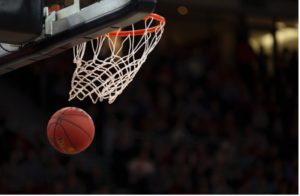
By: Rafael Andino
As of the beginning of September 2022, NBA superstar Luka Doncic has been in a trademark dispute with a rather unlikely party: his mother, Mirjam Poterbin.[1] The Dallas Mavericks guard has made an effort to register a new trademark, his name and a “Luka Doncic 77” logo through the United States Patent and Trademark Office (“USPTO”).[2] An older trademark held by his mother, “Luka Doncic 7”, stands in the way of Doncic’s efforts to successfully register the new trademark.[3] Luka99, Inc. (“Luka99”), a Delaware multimedia company dedicated to promoting Doncic’s name, image, and likeness (“NIL”), unsuccessfully tried to register “Luka Doncic” and “Original Hoops of Luka Doncic” in 2021.[4] The USPTO denied the registration, citing similarities to the “Luka Doncic 7” trademark held by Poterbin.[5]
Doncic became a professional basketball player in Spain at the age of thirteen.[6] At the time of turning pro, Luka looked to Poterbin for advice and guidance on the business aspects of his athletic career[7] According to a cancellation petition, Doncic admits that he consented to his mother having permission to hold the trademark “Luka Doncic 7”.[8] Nonetheless, Luka99 is petitioning the USPTO to cancel Poterbin’s trademarks on numerous grounds.[9] One reason is that Doncic is no longer “affiliated or associated with [Poterbin] or its goods and services.”[10] The cancellation petition states that Doncic has increased his own business judgment, and Poterbin’s assistance is no longer necessary with regard to Doncic’s business affairs.[11] Additionally, he “does not approve or sponsor [these] goods and services.”[12] The cancellation petition cites abandonment as its cancellation basis, and cites sections 2(a) and 2(c) of the Lanham Act.[13] The problem, according to Luka99, lies with the consumer’s presumption of Luka’s connectedness with the “Luka Doncic 7” trademark.[14]
The implications of Doncic’s trademark dispute and revocation of his consent can potentially reach much further than Doncic’s own situation. In an interview with Sportico, Alexandra Roberts, a trademark law expert, stated that “guidance on the question of what to do when consent to register a mark that references a famous individual is granted and then subsequently revoked is surprisingly scant.”[15] Roberts additionally remarks that the Lanham Act and the Trademark Manual of Examining Procedure are “silent on whether consent can be revoked and to what effect.”[16] The effect of Doncic’s situation could create precedent for college athletes in matters involving NIL rights.[17] Although Doncic was nineteen years old when Poterbin registered the mark,[18] similarities can be found in Doncic’s case and situations amongst college athletes across the country who have signed NIL contracts with the guidance of parents and/or agents[19]. Roberts stressed, though, that the law may favor of Poterbin.[20] Since the Lanham Act and the Trademark Manual of Examining Procedures only require consent at the time of the registration, Poterbin may very possibly come out on the winning side of this trademark battle.[21] According to Roberts, a decision for Poterbin “may have ramifications for college athletes, who should proceed with caution if a company they endorse seeks their consent to register marks that reference them and understand that consent could permanently jeopardize their ability to use their name, nickname, or likeness as a mark if it creates a likelihood of confusion with other marks that reference them.”[22]
Based on Roberts’ insight in conjunction with the Lanham Act’s and the Trademark Manual of Examining Procedure’s languages, Poterbin has an extremely strong case against the cancellation petition. Due to its loose language, the Lanham Act does not expressly appear to provide for the withdrawal of one’s consent once given.[23] A favorable result for Poterbin could influence other young athletes, celebrities and people of interest who receive guidance from an agent, parent or legal guardian to carefully consider or potentially reconsider deals with businesses acquiring their name, image, and likeness rights. In a relatively new market with over 460,000 student athletes who are eligible to market businesses through NIL deals[24], the implication of Doncic’s consent dispute could have rippling effects on hundreds of thousands of people across the country.
[1] See Kyle Jahner, Luka Doncic Bid to Get Trademark Back From Mom a Legal Jump Ball, Bloomberg Law (Sept. 19, 2022, 5:10 AM), https://www.bloomberglaw.com/bloomberglawnews/ip-law/XDN1GIDO000000?bna_news_filter=ip-law.
[2] See id.
[3] See Michael McCann, Luka Doncic Embroiled in Unusual Trademark Dispute With His Mother, Yahoo Sports (Sept. 13, 2022), https://sports.yahoo.com/luka-don-embroiled-unusual-trademark-130000080.html?guccounter=1&guce_referrer=aHR0cHM6Ly93d3cuZ29vZ2xlLmNvbS8&guce_referrer_sig=AQAAAH4TTSy-W8miFne9TmdY5btEZ5vPFgxvW2R7Gu_3B5jX2RU7DycxQKCSv9mQcXpqS5hwYam5GHPqBZEfh1yOzWk9Msuk6ujeYSRdMqXdC_w6qxL6Xg68P4fbRjkRE6VMHlVvDQEphvi_7yC7xyfhvtjppaafNxNeZJ0TagBAgodw.
[4] See id.
[5] See id.
[6] See Techdirt, Luka Doncic’s Trademark Dispute With His Mother Is In Uncharted Trademark Territory, Above The Law (Sept. 16, 2022, 10:04 AM), https://abovethelaw.com/2022/09/luka-doncics-trademark-dispute-with-his-mother-is-in-uncharted-trademark-territory/.
[7] See id.
[8] See Jahner, supra note 1
[9] See Techdirt, supra note 6.
[10] See id.
[11] See Luka99, Inc. v. Poterbin, 92080484-CAN (T.T.A.B. filed Sept. 6, 2022).
[12] See Techdirt, supra note 6
[13] See Jahner, supra note 1; see also 15 U.S.C. §1052(a) (stating the false association ban); 15 U.S.C. §1052(c) (stating the ban for marks referencing living persons without consent).
[14] See McCann, supra note 3.
[15] See id.
[16] See id.
[17] See James Parks, What is NIL in college football? Here’s what you need to know, Sports Illustrated (May 23, 2022, 2:43 PM), https://www.si.com/fannation/college/cfb-hq/ncaa-football/college-football-nil-rule-changes-what-you-need-to-know (“Players can accept money from businesses in exchange for using them in products or advertisements, and can also promote themselves or other companies in public appearances.”).
[18] See Jahner, supra note 1
[19] See Dan Whateley & Colin Salao, How college athletes are getting paid from brand sponsorships as NIL marketing takes off, Business Insider (Sept. 7, 2022, 2:29 PM), https://www.businessinsider.com/how-college-athletes-are-getting-paid-from-nil-endorsement-deals-2021-12 (stating that college athletes have worked with national brands, small businesses, and startups to make money from their names, images, and likenesses).
[20] See McCann, supra note 3.
[21] See id.
[22] See id.
[23] See §1052(a) (stating the false association ban); §1052(c) (stating the ban for marks referencing living persons without consent).
[24] See Whateley & Salao, supra note 19.

